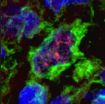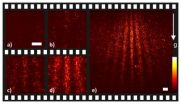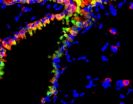(Press-News.org) UCLA researchers pinpointed a new mechanism that potently activates T-cells, the group of white blood cells that play a major role in fighting infections.
Published March 25 online in Nature Medicine, the team specifically studied how dendritic cells, immune cells located at the site of infection, become more specialized to fight the leprosy pathogen known as Mycobacterium leprae. Dendritic cells, like scouts in the field of a military operation, deliver key information about an invading pathogen that helps activate the T-cells in launching a more effective attack.
It was previously known that dendritic cells were important for a strong immune response and the number of such cells at an infection site positively correlated with a robust reaction. However, until now it was poorly understood how dendritic cells become more specialized to address specific types of infections.
The researchers found that a protein called NOD2 triggers a cell-signaling molecule called interleukin-32 that induces general immune cells called monocytes to become specialized information-carrying dendritic cells.
"This is the first time that this potent infection-fighting pathway with dendritic cells has been identified, and demonstrated to be important in fighting human disease," said the study's first author Mirjam Schenk, postdoctoral scholar, division of dermatology, David Geffen School of Medicine at UCLA.
In conducting the study, scientists used monocytes taken from the blood of healthy donors and leprosy patients and incubated the cells with the pathogen M. Leprae or specific parts of the mycobacteria, known to trigger NOD2 and TLR2, both associated with immune system activation.
Scientists wanted to investigate how these proteins might trigger mechanisms that turn on different immune receptors that recognize specific parts of the microbe in an infection. The NOD2 interleukin-32 pathway was the most effective and caused monocytes to develop into dendritic cells that carry critical information about the pathogen to the T-cells.
The team studied the gene expression profiles of the protein-triggered pathways and then also examined how the monocytes of leprosy patients responded to NOD2. Scientists found that NOD2 worked to induce moncytes to dendritic cells in tuberloid leprosy, a milder infection that is more easily contained. The NOD2 pathway was inhibited and could not be activated in lepromatous leprosy, which is more serious and causes widespread infection throughout the body.
"We were surprised to find the high potency of the dendritic cells in triggering certain specific T-cell responses, which may be useful in developing new therapeutic strategies for infectious diseases and cancer," said senior investigator Dr. Robert Modlin, UCLA's Klein Professor of Dermatology and chief of dermatology at the Geffen School of Medicine.
Leprosy, one of the world's oldest known diseases, is a chronic infectious disease that affects the skin, the peripheral nerves, the upper respiratory tract and the eyes and can lead to disfigurement of the hands, face and feet. In 2008, approximately 249,000 new cases of leprosy were reported worldwide, according to the World Health Organization.
Modlin adds that leprosy is a good model to study immune mechanisms in host defense since it presents as a clinical spectrum that correlates with the level and type of immune response of the pathogen.
The next stage of research will involve trying to further understand how to manipulate the innate immune system to induce a potent immune response in human infections and possibly for cancer immunotherapy as well.
INFORMATION:
The study was funded by the NIH's National Institute of Allergy and Infectious Diseases and National Institute of Arthritis and Musculoskeletal and Skin Diseases. (Grant numbers: RO1s AI022553, AR040312 and AI047868.)
Additional authors include: Stephan R Krutzik, Peter A Sieling, Delphine J. Lee, Rosane M. B. Teles, and Maria Teresa Ochoa from the Division of Dermatology, Department of Medicine, David Geffen School of Medicine at UCLA; Genhong Cheng, Department of Microbiology, Immunology and Molecular Genetics, David Geffen School of Medicine at UCLA; Evangelia Komisopoulou and Thomas G. Graeber, Crump Institute for Molecular Imaging, Institute for Molecular Medicine, Jonsson Comprehensive Cancer Center, California NanoSystems Institute, Department of Molecular and Medical Pharmacology, UCLA; Euzenir N. Sarno, Department of Mycobacteriosis, Oswaldo Cruz Foundation, Rio de Janeiro, Brazil; Thomas H. Rea, Department of Dermatology, University of Southern California School of Medicine, Los Angeles, California and Soohyun Kim, Department of Biomedical Science and Technology, Konkuk University, Seoul Korea.
UCLA scientists identify novel pathway for T-cell activation in leprosy
Finding may help develop new treatments for infectious diseases, cancer
2012-03-26
ELSE PRESS RELEASES FROM THIS DATE:
Houston Lawyer Jay Jackson Earns a "Standing Ovation" for Volunteer Work with the State Bar of Texas
2012-03-26
Personal injury attorney Clyde J. "Jay" Jackson III, of Abraham, Watkins, Nichols, Sorrels, Agosto and Friend in Houston, Texas, was honored this month by the State Bar of Texas for his exceptional contributions in 2011 to the organization's legal education efforts. Mr. Jackson was one of only six volunteer lawyers who were recognized by the TexasBarCLE, the division of the bar that provides continuing legal education.
Explaining the significance of the "Standing Ovation" award, TexasBarCLE Director Patrick said, "All of our volunteers deserve ...
A hidden architecture: Researchers use novel methods to uncover gene mutations for common diseases
2012-03-26
BOSTON, MA—Human geneticists have long debated whether the genetic risk of the most common medical conditions derive from many rare mutations, each conferring a high degree of risk in different people, or common differences throughout the genome that modestly influence risk.
A new study by Brigham and Women's Hospital (BWH) researchers has harnessed data and new analysis tools to address this question in four common diseases: rheumatoid arthritis; celiac disease; coronary artery disease and myocardial infarction (heart attack); and type 2 diabetes.
The study will ...
Vaccinating chickens could prevent food-borne illness
2012-03-26
A vaccine could be developed to prevent Campylobacter being carried in chickens. This approach could drastically cut the number of cases of food poisoning, saving the UK economy millions each year, says an American scientist presenting his work at the Society for General Microbiology's Spring Conference in Dublin.
Food-borne illness costs the UK an estimated £2 billion each year. Campylobacter is the leading cause of food-borne illness and is responsible for about 30% of cases in the UK. Campylobacter jejuni was responsible for more than 371,000 estimated cases in England ...
Single molecules in a quantum movie
2012-03-26
The quantum physics of massive particles has intrigued physicists for more than 80 years, since it predicts that even complex particles can exhibit wave-like behaviour – in conflict with our everyday ideas of what is real or local. An international team of scientists now succeeded in shooting a movie which shows the build-up of a matter-wave interference pattern from single dye molecules which is so large (up to 0.1 mm) that you can easily see it with a camera.
This visualizes the dualities of particle and wave, randomness and determinism, locality and delocalization ...
New Illinois Seatbelt Law Will Increase Safety
2012-03-26
Wearing seatbelts saves lives. A new Illinois seatbelt law intends to get more people wearing seatbelts and thus save more lives.
Starting the first day of 2012 the new seatbelt law requires that all passengers in vehicles need to wear seatbelts with some exceptions. Prior to the new law only passengers in the front seat and children riding in the backseat were required to wear seatbelts. Under the new law everyone in the car needs to wear a seatbelt regardless of age or seat positioning unless they are exempt of the law. A minimum fine of $25 is imposed for violators ...
Scratching the surface of social interaction
2012-03-26
It can be difficult to uncover the behavior of small, shy, nocturnal primates like the brown mouse lemur (Microcebus rufus), especially in the dense rainforests of Madagascar where this lemur lives. New research published in BioMed Central's open access journal BMC Ecology shows that the social interactions of brown mouse lemurs can be monitored by mapping the transfer of tagged lice.
Brown mouse lemurs are the only known host of the parasitic louse Lemurpediculus verruculosus. The lice have evolved to stay attached to the sparse hair on the lemurs' ears, where they feed ...
Phoenix Business Consulting Firm Launches New Website to Help Small Businesses Become Mobile Friendly As Most Businesses Are Now Losing 1/3 Of Their Web Traffic To "Small Screen Syndrome"?
2012-03-26
Expert mobile marketing consultant Mark Stafford and his Phoenix Business Consulting Firm Arizona Social Media LLC have just launched a new website to help small businesses become mobile friendly on the internet and avoid "small screen syndrome".
82% of small business websites do not display correctly on the average smartphone thus the user must "slide & pinch" the webpage on their smartphone screen in order to consume the content.
Many small business owners do not realize what they are up against in this new "mobile marketplace":
- More ...
Weather records due to climate change: A game with loaded dice
2012-03-26
The past decade has been one of unprecedented weather extremes. Scientists of the Potsdam Institute for Climate Impact Research (PIK) in Germany argue that the high incidence of extremes is not merely accidental. From the many single events a pattern emerges. At least for extreme rainfall and heat waves the link with human-caused global warming is clear, the scientists show in a new analysis of scientific evidence in the journal Nature Climate Change. Less clear is the link between warming and storms, despite the observed increase in the intensity of hurricanes.
In 2011 ...
Inner weapons against allergies: Gut bacteria control allergic diseases
2012-03-26
PHILADELPHIA - When poet Walt Whitman wrote that we "contain multitudes," he was speaking metaphorically, but he was correct in the literal sense. Every human being carries over 100 trillion individual bacterial cells within the intestine -- ten times more cells than comprise the body itself.
Now, David Artis, PhD, associate professor of Microbiology, along with postdoctoral fellow David Hill, PhD, from the Perelman School of Medicine at the University of Pennsylvania, and collaborators from The Children's Hospital of Philadelphia and institutions in Japan and Germany, ...
PuckProspect.com Hockey Scouting and Hockey Recruiting Website Not in the Daily News Yet
2012-03-26
PuckProspect.com (www.puckprospect.com) introduced it's hockey scouting and hockey recruiting service with not much fanfare. It did not make msnbc news or even the daily news. It did however serve notice that another online player is bidding for recognition in the relatively small world of internet hockey recruiting and hockey scouting services.
PuckProsect.com' s hockey scouting and hockey recruiting service is not for everyone! It's not for football players, baseball players, basketball players... you get the idea. It's for hockey people! Unlike other scouting websites ...
LAST 30 PRESS RELEASES:
Safety decision-making for autonomous vehicles integrating passenger physiological states by fNIRS
Fires could emit more air pollution than previously estimated
A new way to map how cells choose their fate
Numbers in our sights affect how we perceive space
SIMJ announces global collaborative book project in commemoration of its 75th anniversary
Air pollution exposure and birth weight
Obstructive sleep apnea risk and mental health conditions among older adults
How talking slows eye movements behind the wheel
The Ceramic Society of Japan’s Oxoate Ceramics Research Association launches new international book project
Heart-brain connection: international study reveals the role of the vagus nerve in keeping the heart young
Researchers identify Rb1 as a predictive biomarker for a new therapeutic strategy in some breast cancers
Survey reveals ethical gaps slowing AI adoption in pediatric surgery
Stimulant ADHD medications work differently than thought
AI overestimates how smart people are, according to HSE economists
HSE researchers create genome-wide map of quadruplexes
Scientists boost cell "powerhouses" to burn more calories
Automatic label checking: The missing step in making reliable medical AI
Low daily alcohol intake linked to 50% heightened mouth cancer risk in India
American Meteorological Society announces Rick Spinrad as 2026 President-Elect
Biomass-based carbon capture spotlighted in newly released global climate webinar recording
Illuminating invisible nano pollutants: advanced bioimaging tracks the full journey of emerging nanoscale contaminants in living systems
How does age affect recovery from spinal cord injury?
Novel AI tool offers prognosis for patients with head and neck cancer
Fathers’ microplastic exposure tied to their children’s metabolic problems
Research validates laboratory model for studying high-grade serous ovarian cancer
SIR 2026 delivers transformative breakthroughs in minimally invasive medicine to improve patient care
Stem Cell Reports most downloaded papers of 2025 highlight the breadth and impact of stem cell research
Oxford-led study estimates NHS spends around 3% of its primary and secondary care budget on the health impacts of heat and cold in England
A researcher’s long quest leads to a smart composite breakthrough
Urban wild bees act as “microbial sensors” of city health.
[Press-News.org] UCLA scientists identify novel pathway for T-cell activation in leprosyFinding may help develop new treatments for infectious diseases, cancer





